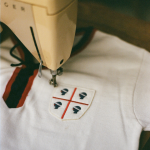
Hummel decided to stay in the 1980s
Next season, the teams sponsored by the brand will use the same famous template from 1986
June 21st, 2023
When the Danish national team fielded a jersey designed by the domestic brand Hummel for the first time in 1986, reactions were not uniformly enthusiastic - many thought the design was a carnival, far removed from the aesthetic standards of the time. Instead, the jersey quickly caught on, revolutionising the style of footballers on the pitch and paving the way for future designs that would dominate in the years that followed. But now, as part of the huge trend eating up club archives, between vintage obsession and the eternal return of fashion cycles, Hummel has decided to reissue the same design that made history in the late 1980s.
First it was the Danish national team that wore a special jersey in their last match against Northern Ireland, after announcing it with great enthusiasm. And shortly afterwards, new kits for some of the top teams were unveiled for the next season, again based on the same template, which at the time was called a "carnival suit". First Southampton, then Koln, then St Etienne and finally Brøndby, they will all wear the jersey as a tribute to the history of the Danish technical sponsor. But Real Betis, Werder Bremen and Everton, Hummel's remaining flagships, will also soon join this archival campaign, if predictions are to be believed. Some of these teams, such as Southampton, had already donned this template in the iconic 1980s. Others, however, such as Werder and Brøndby, although sponsored by Hummel in the past, had other jerseys, while both St Etienne and Cologne are making their first experiences with the brand and will only use the tone-on-tone template with the thin stripes for the away jersey.
Hummel has never made a secret of the fact that it wants to bring back the template that created the myth of the danish Chevrons. Over the decades it has been reused here and there for the most unlikely of clubs, but never in such a systematic way. While fashion brands are rediscovering the importance of their own archives and technical sponsors are still undecided on whether or not to use a uniform template, Hummel has decided to answer yes to every request from fans and collectors by exploiting every bit of intellectual property in its possession. After letting some of its contracts fall through last year due to the bankruptcy of its UK distributor, the Danish brand is back at it with jerseys so iconic that everyone just has to like them. But such a strategy also has its downsides, such as trivialising an iconic design by using it in every jersey.
And the risk of Hummel reducing all its creativity and aesthetics to a single - albeit historic - design is palpable, even among the insiders who comment on the latest jersey presentations. As much as the obsession with vintage jerseys is more than just a trend, part of the appeal lies precisely in the uniqueness of the collectible, in the difficulty of the search that unites every fan. The Danish brand is trying to break this spell by taking refuge in the past instead of betting on the future of football jerseys and confirming that for some people, you can not get out of the 1980s alive.












